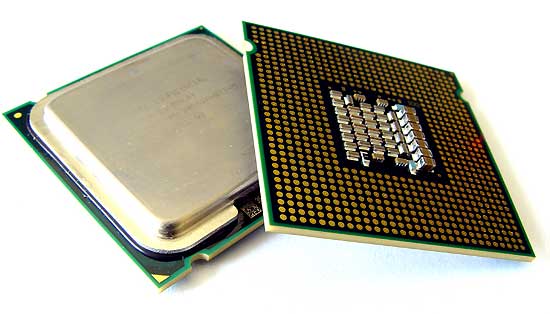Page 2 - Specs
Intel today (November the 12th) will release officially it's first new processor from the Penryn series of products. Penryn is all about the eternal quest for a smaller die-size. The fabrication process of Penryn is at an incredibly small 45nm. See, smaller transistors equal lower power consumption, equal less heat equal higher clock frequencies and that equals into better performance. The previous generation CPU's QX6850 was built on a 65nm fabrication process. Intel estimates that downscaling that process could save up-to 30% in power consumption.
The Core 2 Exteme QX9650 processor is the first in the Penryn series that has been released. Expect other Penryn based processors somewhere in January 2008, we'll show you a list later on at this page. For now, the new flagship Core 2 Extreme QX9650 is available as of the 12th of November. A truly breathtaking quad-core processor at 3.0 GHz developed under codename Yorkfield.

So what's the deal with the code "thingy" names ?
Yeah, it might be a little confusing I agree. But Intel has got two things separated and coded. These are processor family codenames and next to that the actual chip codenames. It's pretty simple though:
Penryn refers to the entire family of 45nm Core architecture products that have been or will be announced, the actual chips themselves all have their own codenames.
For example in the 45nm Penryn range you'll see the following product codenames:
A Penryn based quad-core Xeon processor is codenamed Harpertown.
A Penryn on the desktop carries two names: Yorkfield and Wolfdale.
Yorkfield is a quad-core Penryn for the desktop, Wolfdale is simply dual-core. In fact, a Yorkfield chip is made out of two Wolfdale dies on the same silicon (that's similar to the current quad-core Kentsfield Intel CPUs).
So the Penryn processor we are testing today QX9650 has codename Yorkfield, is made up of two independent (Wolfdale) dual-core die on one package and each one has a shared 6 MB L2 cache with a total of 12MB of on-chip L2 cache.
So next to that smaller fab process there are a number of small changes added to QX9650. Firstly, as mentioned already above, opposed to the previous-gen product the L2-cache has been increased significantly. For dual-core processors you'll see a move from 4 towards 6MB. The quad core processors will get a lovely upgrade from 8 towards 12 MB L2 cache. Intel also added the long awaited instruction set SSE4 which in the future will guarantee a huge speedup for a good number of multi-media applications. Think here in en/decoding DiVX in HD and what not.
Accumulating cache and adding instruction sets to a processor with four cores does require an additional number of transistors. Where the current (65nm) generation of Quad core processors has 582 million transistors, Penryn has roughly 820 Million (give or take a few). That's 40% more, yet the die-size is smaller thanks to the new 45nm fab process. 286 mm² for Kentsfield (current quad core codename) and 214 mm² for Yorkfield (the Penryn based Quad core codename).

Windows Task Manager will immediately display four active cores.
Mainboard support
What's interesting is that the QX9650 will work in a good number of shipping motherboards. The chip is still an LGA-775 processor so it'll fit in any LGA-775 socket. That doesn't mean that all LGA775 mainboard can run this processor though. Pretty much P35, G33 and X38 chipsets and future will run Penryn, you'll need a BIOS update though, please contact your vendor about that.
I however am extremely pigheaded at times and got on the phone with NVIDIA as I was curious if the processor could work on their nForce 680i platform. After receiving a beta BIOS (P31- should be available as we speak) we did spot a couple of bugs, yet we had fully working Penryn support which was good enough for our test. Hey; you know how much I love 680i right ? The reason I wanted to test on 680i was based on one fact, overclocking. If there's so much power consumption going on on this 45nm we can surely waste it with an excessive overclock. And actually, we'll show you some impressive stuff today.
Pricing then; expect the QX9650 to come in at $999, likely a little lower in e-tail here and there. As stated before, this is the first Penryn seriers based processor. What will happen in the weeks to come ? Have a look at the chart below.
|
TBA Penryn Family processors |
||||||||||||||||||||||||||||||||||||||||||||||||||||||||||||||||||||||||||||||||||||||||||||||||||||||||||||||
|
||||||||||||||||||||||||||||||||||||||||||||||||||||||||||||||||||||||||||||||||||||||||||||||||||||||||||||||
Correct, there will be a 3,2 GHz version as well. Quite conservative as the architecture allows much higher clock-frequencies (we'll demonstrate that later in the article). Also spot that Q9300 processor. That's going to be a mainstream sweet spot quad core CPU based on Penryn. It'll pretty much be the new Q6600.
